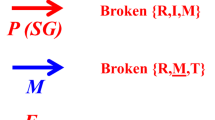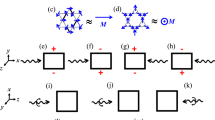Abstract
According to Weiss's well-known theory, a ferromagnetic body in the absence of an external magnetic field must be spontaneously magnetised in such a way that the direction of magnetisation varies in an irregular manner in different portions of the body. It was originally assumed by Weiss that these portions coincide with the minute crystals of which the body is built up. That this is not so is clear from the fact that spontaneous magnetisation (as revealed by the existence of a Curie temperature) is present also in single crystals. We are thus forced to assume that a moderate-sized single crystal of a ferromagnetic body consists of a number of ‘elementary magnets’ the resultant magnetic moment of which vanishes. This spontaneous subdivision of a ferromagnetic body into elementary magnets can be interpreted both qualitatively and quantitatively in the following manner.
This is a preview of subscription content, access via your institution
Access options
Subscribe to this journal
Receive 51 print issues and online access
$199.00 per year
only $3.90 per issue
Buy this article
- Purchase on Springer Link
- Instant access to full article PDF
Prices may be subject to local taxes which are calculated during checkout
Similar content being viewed by others
References
See also J. Frenkel, Z.f. Phys., 49, 34; 1928.
Cf. M. Born u. Kornfeld, Phys. Zs., 24, 121; 1923.
Author information
Authors and Affiliations
Rights and permissions
About this article
Cite this article
FRENKEL, J., DOEFMAN, J. Spontaneous and Induced Magnetisation in Ferromagnetic Bodies. Nature 126, 274–275 (1930). https://doi.org/10.1038/126274a0
Issue Date:
DOI: https://doi.org/10.1038/126274a0
This article is cited by
-
A literature review of MOF derivatives of electromagnetic wave absorbers mainly based on pyrolysis
International Journal of Minerals, Metallurgy and Materials (2023)
-
Graphene aerogel induced by ethanol-assisted method for excellent electromagnetic wave absorption
Journal of Materials Science (2022)
-
Electromagnetic response and microwave absorption properties of CF/Fe3O4 absorbing composites
Journal of Materials Science: Materials in Electronics (2022)
-
Investigation on the critical factors of MoSe2-based microwave absorbing property
Journal of Materials Science: Materials in Electronics (2021)
Comments
By submitting a comment you agree to abide by our Terms and Community Guidelines. If you find something abusive or that does not comply with our terms or guidelines please flag it as inappropriate.



